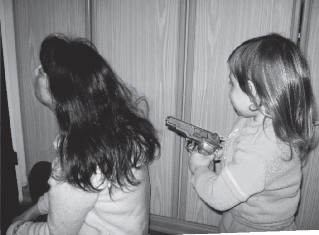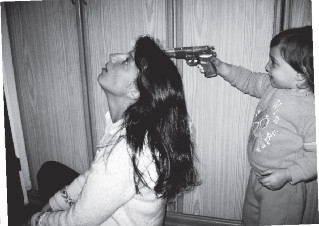Are we Victims of Fake News?
Two-and-half year-old Girl Murders Mother. Vicious Crime Committed
Photos by Judith Farris
In a fast action crime this two-and-half year-old girl suddenly got angry at her mother, found this 45mm pistol and shot her. The action took place so fast that her grandmother was not able to stop it although she happened to be photographing her daughter at that moment and she got the scoop on camera. A real Alfred Hitchcock drama.
What caused this bloody action? The story is gruesome but could happen anywhere that allows small arms to be carried freely. This was not a staged performance, but actually took place.
The Real Story
The real story is that the little girl's (Kinneret) grandma from time to time dries her granddaughter's hair with a hairdryer, which is shaped sort of like a pistol. Kinneret saw the toy pistol, which belonged to her mother at some time in the past and thinking that it was a hairdryer like that used by her Grandma, wanted to dry her mother's hair. And Grandmother Judith snapped these shots.
Lesson Learned
What lesson can we learn from this sequence of pictures and little story? Before attempting to answer that question, one must consider what is still photography? Still photography makes no difference if we are using film or digital, but it captures an instant in time. We do not know what came before the picture was taken, nor do we know what came after the picture was taken. In short, still photography shows us a thin slice of time. The camera, or photographer, has framed and captured an instant of time. When looking at a photograph we cannot be sure exactly what segment of time was captured, nor do we know how the photographer might have manipulated the photograph. So can the camera lie, not really; can the photographer lie, definitively yes.
Ethical Journalism
This raises the question about how ethical journalism really is. Considering the most urgent boundary of traditional journalism is the deadline, then just how accurate can newspapers be? How closely can a story be checked and verified for accuracy or even correctness? A newspaper that does not meet the "on the street" due time is useless. So, the big driving force behind traditional newspapers is getting onto the street on time. How does this impact on accuracy?
Joseph Pulitzer, the well-known newspaper maven, has stated that the three rules of journalism are: "accuracy, accuracy, accuracy". Just how well is this lived up to? How much time is spent in cross-referencing sources when the deadline hangs like a Damascus sword? The studies on newspaper accuracy are rather mixed, but the majority of studies clearly point to a 50% or greater error rate. In a recent lecture that I attended by the well-known Israeli crime reporter, Guy Peleg, he told us that more often than not published reporting is more inaccurate than accurate. There generally is little time to cross-reference the story.
The same holds true for Web or digitally distributed news and reporting. Although in this case, the story can be more easily modified to correct errors. But are the errors actually corrected and how easily can a reader find the corrections?
A few years ago, the National Geographic in an unprecedented editorial explained why they fired a photographer for incorrectly reporting how he made the photographs. National Geographic does not generally allow staging photographs, unless specifically stated that this was done. The photographer in question had staged some photos in a story but did not report this. As surprising as the firing was, this action pointed out the importance of honest and accurate journalism. How many news sources are this ethical? The Reuters news agency has published a comprehensive online "Handbook of Journalism" http://handbook.reuters.com/index.php?title=Main_Page. In a section labelled Standards and Values they include a detailed subsection on accuracy. The category commences with this statement:
"Accuracy is at the heart of what we do. It is our job to get it first but it is above all our job to get it right. Accuracy, as well as balance, always takes precedence over speed." http://handbook.reuters.com/index.php?title=Accuracy
This is excellent in theory, but are their stringent guidelines actually carried out in practice?
If a news source has to meet that deadline, we must ask ourselves if it is accurate. If the news source is sponsored by some industry, or supports a political direction, is their reporting accurate. These are all issues that we should consider when taking in our news.
So, our little story of "Two-and Half-Year-Old Girl Murders Mother" is a small example of how we should read or hear our news with some reserve. We should try and not be naïve readers and automatically assume that the news is accurate and correct. So how can we determine if news or news reports are responsible with integrity; if the news reports are biased, subtly leaning in one direction only; or are if the news and reports are the now ubiquitous fake news? It is left to you, the intelligent reader, to make that decision.











Comments